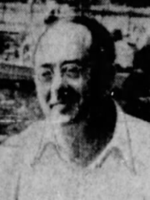 AP - 6/18/1955 Journalist Edward J. Mowery, a top investigative reporter with the New York World-Telegram and Sun, had uncovered evidence in several cases in the 1940s and 1950s proving the innocence of falsely accused prisoners. He became interested in the case of Louis Hoffner when he learned that the assistant district attorney, Harry G. Anderson, believed Hoffner was innocent. In 1947, together with New York City patrolman Bernard Arluck, Mowery was able to uncover evidence to prove Hoffner’s innocence. Hoffner, a 27-year-old assistant theater manager, had been convicted of the 1940 slaying of a Queens, New York, bartender during a burglary, and sentenced to life imprisonment on January 16, 1941. Both the Appellate Division and Court of Appeals upheld his conviction. The basis for Hoffner’s conviction was the identification by one witness. However, in 1947, the case was re-opened due to new evidence of innocence, but an appeal for a new trial was denied. In 1948, Governor Thomas E. Dewey refused to pardon him. The decision not to consider the new evidence may have been prejudiced by Hoffner’s criminal record, which included three past arrests: he had been arrested at the age of 19 for assault and battery, but the case had been dismissed; he had been convicted at 21 for filing a false auto registration and put on probation; and at 23, he had pleaded guilty to larceny and had been sentenced to prison. However, still convinced of his innocence in the murder, Mowery, Anderson, and Arluck formed the “Hoffner Committee,” through which many prominent citizens tried to have Hoffner released, but Hoffner’s appeals continued to be ignored. During the course of the investigation, this committee had learned that the following vital evidence had not been presented at the trial which would have proven his innocence: three friends who were with Hoffner in Brooklyn at the time of the murder were never called as witnesses and would have provided his alibi; two men who saw the killer flee were never called; and only one vacillating witness had identified Hoffner as the killer and had then admitted doubts about his identification. Finally, when presented with these findings in 1952, Queen County Judge Peter T. Farrell set aside the conviction and the sentence, basing his decision on the ground that vital evidence had not been presented at the trial which would have proven Hoffner’s innocence. After twelve years in prison, Hoffner was released. In 1953, Mowery won a Pulitzer Prize in journalism for his reporting on Hoffner’s case. In 1955, a State Court of Claims judge awarded Hoffner $112,291 as compensation for his wrongful conviction and twelve years in prison. - Researched by Willie Jamison and Stan Matthews
|